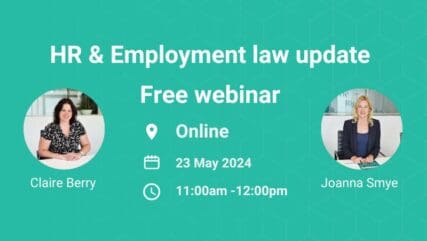
HR & Employment law 2024 update webinar
Join our experts for an important employment law update webinar, delivered by our employment solicitors, Claire Berry and Joanna Smye, who will discuss the most important employment law changes in 2024.
What do the latest accounting changes mean for you?
The Financial Reporting Standard (FRS) 102 is the most recent and most important of a trio of new UK GAAP (Generally Accepted Accounting Standards) applicable in the UK and the Republic of Ireland.
The standard followed an extensive and detailed development and consultation process and is the culmination of a process to replace UK GAAP that began nearly ten years ago. The measures contained took effect from periods beginning on or after 1 January 2015.
The introduction of FRS 102 will have a major impact on the financial statements of any entity currently preparing accounts under UK GAAP and has therefore lead to a change in accounting for most UK companies.
FRS 102, together with FRS 103 which specifically deals with insurance contracts, replaces all current UK accounting standards (SSAPs, FRSs and UITFs).
In addition to changes to the format of financial statements and the disclosures required, for many businesses there are changes to the numbers when compared to UK GAAP.
For example:
Changes in the numbers may have implications beyond just the accounts. Practical and resourcing issues also need to be considered. Particularly where there are long-term arrangements such as bank loans which could be affected.
One of the key practical aspects of the change in accounting is the impact it has on a company’s tax.
Of the many changes, there are real opportunities to gain a tax advantage with:
Equally there are potentially harmful tax and deferred tax liabilities hiding in the detail for loan relationships, financial instruments and revaluations.
Some companies will have accelerated a dividend pre 5 April 2015 for income tax reasons without considering the impact of FRS102 on distributable reserves – the changes in the worst instance could be a serious burden.
As always, a comprehensive impact assessment will be vitally important in determining whether your business can or will benefit from these changes.
We have already helped many of our clients through the new accounting changes and we can do the same for you too.
Our FRS 102 services our very cost-effective to help you get you ready as soon as possible. Please get in touch with us to discuss further.
Use the links below to jump to a section:
In some cases, the application of the new standard and any subsequent prior period adjustments may have an impact on taxable profits, which could mean either additional tax becoming payable or less tax being payable.
Other important considerations include the impact of changes on the calculation of loan covenants and on profit-related bonuses.
The greatest changes will be felt by companies with financial instrument transactions (for example interest rate swaps or forward contracts for foreign exchange), defined benefit pension schemes, investment properties and investments in listed shares. However, all entities will be affected in some way and in many cases their reported profits will be different.
There are a number of subtle changes and there are also some more significant ones. We have not provided below a full list of all the these but have just highlighted some. We will address further issues in future updates.
The new standard introduces additional options for the names of parts of the financial statements and changes the way that certain items are disclosed. Many entities, however, will not see a great deal of change in the way that their accounts are presented other than, for example, the use of the term ‘inventories’ rather than ‘stocks’.
The Balance Sheet and Profit and Loss account are renamed the Statement of Financial Position and Income Statement. However the standard allows companies to continue to use the old names (For the rest of the document we have continued to use the old names)
A Statement of Comprehensive Income will be required. This is broadly a replacement for the Statement of Total Recognised Gains and Losses (STRGL). However, unlike the STRGL it can be presented as a single statement, following on from the Profit and Loss Account.
A Statement of Changes in Equity will be required, to show movements on each element of capital and reserves. In many cases the only changes in these amounts will arise from the profit for the period and dividends paid. In these cases the changes can be shown at the end of the Profit and Loss Account rather than including a separate Statement of Changes in Equity.
The Statement of Cash Flows shows changes in cash and cash equivalents in the period rather than just cash, as is currently the case.
For most companies this will have no effect; however those companies which have entries in the Management of Liquid Resources section of their current Cashflow Statement will need to consider whether these items will be reclassified as cash equivalents.
In addition the Statement of Cash Flows will be reorganised into just three sections: operating, investing and financing
On transition to FRS 102 companies may elect to treat the revalued amount of certain assets, arrived at using UK GAAP before the transition date, as its deemed cost at the date of revaluation.
This applies to tangible fixed assets, investment properties or intangible assets (other than goodwill).
You may therefore want to consider whether to revalue assets under UK GAAP before your transition date (which is the first day of the comparative period in your first FRS 102 accounts) as a way to get some strength on the balance-sheet without having to worry about future revaluations.
Alternatively, assets can be revalued at fair value on the date of transition, even if this was not included in the previous UK GAAP accounts.
The basic principles of accounting for investment properties remain the same (ie they are included at market value). However, there are changes to the definition of investment properties, where the revaluation is recorded and the deferred tax treatment.
There have been some changes to the definition of Investment properties, for example properties which had previously been accounted for as a tangible fixed asset because they were used by another group company may now be an investment property. Both FRS 102 and the previous UK standards require the revaluation of investment properties every year.
However, under FRS 102 this revaluation will be included in the profit and loss account for the year, rather than the STRGL. In addition, companies will need to account for deferred tax based on the amount of tax that they would have to pay if they disposed of the property at the revalued amount. Currently deferred tax is not usually accounted for on investment property revaluations.
Although the revaluation may be accounted for through the Profit and Loss Account it will still not meet the definition of realised and therefore you will need to keep a separate note so you can calculate the amounts of profits available for dividends to shareholders etc.
In addition, under FRS 102 where the fair value of the investment properties cannot be determined without undue cost or effort, such properties can be accounted for at cost less depreciation.
FRS 102 divides financial instruments into basic and other.
Other financial instruments including interest rate swaps and foreign exchange forward contracts are more complicated.
Other financial instruments, such as interest rate swaps and foreign exchange forward contracts, are recognised in the accounts at fair value, with any changes during the year being taken to the profit and loss account. However, there are some exceptions to this when the financial instrument meets the conditions for the company to be allowed to opt to apply the hedging provisions.
If you have hedging arrangements then it will be important to ensure that you have the relevant paperwork in place.
Many of the financial instruments in the ‘other’ category are not currently recognised under current UK standards, their effect being shown when they mature.
The requirement for consolidated accounts is not changed by FRS 102, however the use of merger accounting for transactions other than group reconstructions is not allowed.
The main differences will be in the calculation of goodwill. However, there will be no requirement to recalculate goodwill on business combinations which took place before the company’s transition date (the first day of the comparative accounting period)
It is likely that the goodwill calculated on acquisitions under FRS 102 will be lower as more intangible fixed assets are allowed to be separately identified as part of the purchase. There is no need to recalculate the goodwill on acquisitions before the transition to FRS 102, as there is a specific exemption from the need to do this. However you can choose to adopt a point of time prior to 31 December 2013 and apply the new provisions to all acquisitions subsequent to that date.
In addition goodwill and other intangible assets must be amortised over a finite period, they cannot be considered to have an indefinite useful life. Where no reliable estimate of the useful life can be made the maximum period allowed is five years.
A number of practical examples of measuring turnover for the period are included in FRS 102. It is possible that in some cases turnover and therefore profit, and also tax, may be different as a result of adopting the new standard.
The method of valuing the defined benefit pension scheme liability or asset remains the same under FRS 102. However, the split between those movements which are taken to the profit and loss account and those included in “other comprehensive income” are different, so the reported profit will be affected.
The treatment of multi employer schemes will be different in some cases.
For multi employer schemes where the individual employers are unable to identify their share of the assets and liabilities the companies are currently permitted to account for the schemes as if they were defined contribution schemes in their individual accounts. Typically in these cases the defined benefit liability or asset is only shown in the group accounts.
Under FRS 102 this arrangement will continue for most of the companies involved, although they will now be required to recognise a liability for any committed deficit funding. However, where this is the case the company which is legally responsible for the scheme will recognise the defined benefit liability on its individual balance sheet.
Where companies have given interest free loans or loans with interest below a commercial rate (typically to other group companies) current accounting is usually to ignore the non-commercial nature of the arrangement, under FRS 102 adjustments will be made to recognise this.
The lender is required to account for the loan at the present value of the cashflows that it expects to receive (discounted using a market rate of interest). It will then show an ‘interest’ income over the period of the loan; so that when it comes to be repaid the debtor is equal to the amount received.
This is the case even where the loan is technically repayable on demand. In these cases the lending company will need to estimate when it expects to be repaid.
In principle the treatment by the company receiving the loan will mirror that of the lender. However, it will treat amounts as payable on their due dates rather than when it expects to pay them, so loans repayable on demand will be included as short term creditors at the amount of cash required to settle them, with no discounting.
The principle of spreading the cost of any lease incentives remains, however for some leases the period will be different.
Under current standards lease incentives are spread over the period up to the point when the rentals revert to the market rate (generally taken to be the first rent review). However, under FRS 102 they are spread over the non-cancellable period for which the lessee has contracted to lease the asset together with any further terms for which the lessee has an option to continue to lease the asset when, at the inception of the lease, it is reasonably certain that the lessee will exercise that option.
The section on agriculture in FRS 102 is the first time that this area has been specifically addressed in UK accounting standards.
There are two options for the treatment of crops, either carrying at the lower of cost and net realisable value or fair value less costs to sell at the year end. Where the cost option is taken there is a further option at the point of harvest to revalue to fair value less costs to sell. In either case, where there are changes in value these are shown in the profit and loss account for the year.
FRS 102 also gives details of the disclosures which are required in respect of agricultural assets.
Where untaken holiday pay is owing at the end of the period, it may be necessary to provide for the accrued value in the year-end accounts.
Where a company’s holiday year is not the same as its financial year an accrual will need to be made for any holiday accrued in the period which has not been taken by the period end (and a prepayment in respect of any taken which will only accrue in respect of service after the period end).
A welcome change from current accounting standards for many, is that FRS 102 does not require the publication of the names of any related parties with whom the entity has transactions.
Related parties includes directors, significant shareholders and relevant family members, though HMRC may still request such information separately.
FRS 102 contains a number of disclosure exemptions for Qualifying Entities (ie members of groups where the parent of that group prepares publicly available consolidated financial statements).
These include exemption from the following requirements:
The general principle is that the balances at the opening date of the preceding period are restated based on the new accounting framework, however some exemptions from this.
There are exemptions for:
There are also specific exemptions relating to Public Benefit Entities and to subsidiaries, associates and joint ventures who transition to FRS 102 at a different date from their parent company.
More information can be found via the Financial Reporting Council Standard guidelines
Please contact us if you would like us to help you and your business with FRS 102.
Contact us today to find out more about how we can help you

Join our experts for an important employment law update webinar, delivered by our employment solicitors, Claire Berry and Joanna Smye, who will discuss the most important employment law changes in 2024.

Every quarter, our Academies team will publish the most important and frequently asked helpdesk queries. You can download our 2024 quarterly updates here.

Understand the VAT implications for doctors' practices, from exemptions to reclaiming VAT on taxable supplies. Essential insights for healthcare professionals.



Accounting and advisory firm Price Bailey unveils four new promotions and announces that two new appointments will be joining the Partnership team in the year ahead.